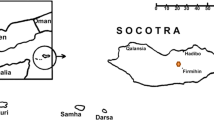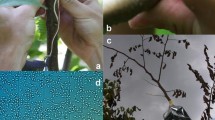Abstract
The thermal dissipation probe was described in the early 1930s for the demonstration of a volume and mass flow of sap in the conductive elements of the xylem in trees. It was subsequently developed further and is now widely used in physiological ecology including measurements in the field. Thermal dissipation demonstrates the occurrence of sap flow and allows determination of its velocity. Here we report simultaneous continuous measurements of sap flow using the thermal dissipation technique and of transpiration by infrared gas analysis for diurnal and annual cycles in a deciduous and an evergreen oak tree, Quercus robur L. and Quercus turneri Willd., respectively, in a deciduous and an evergreen conifer, Larix decidua Mill. and Pinus griffithii McClell., respectively, and the host/mistletoe consortium of the deciduous linden Tilia mandschurica Rupr. & Max. and the evergreen Viscum album L. We show (1) that in diurnal cycles sap flow closely follows dynamic changes of the rate of transpiration elicited by daily fluctuations of weather parameters (sunshine, cloudiness, air temperature and humidity), (2) that in annual cycles sap flow reflects autumnal yellowing and shedding of leaves of the deciduous trees. We report for the first time comparative measurements of sap flow towards mistletoe shoots and host branches in a parasite/host consortium. This demonstrates (3) that mistletoes maintain considerably larger sap flow rates in their xylem conduits than the adjacent host branches dragging the transpiration stream of their host towards their own shoots. We also show (4) that even after the deciduous host has shed its leaves and itself does not transpire any more the evergreen mistletoe towards its shoots can maintain the persistence of a continuous sap flow via the stem and branches of the host as long as frost does not prevent that. The work presented underlines the contention that transpiration is the driving force for sap flow with continuous files of water in the xylem. It shows for the first time that mistletoes direct the flow of water through host roots and stems towards its own shoots by not only performing stronger transpiration as it is known from the literature but also by maintaining larger sap flow rates in the xylem conduits of its stems.






Similar content being viewed by others
References
Angeles G, Bond B, Boyer JS, Brodribb T, Brooks JR, Burns MJ, Cavender-Bares J, Clearwater M, Cochard H, Comstock J, Davis SD, Domec J-C, Donovan L, Ewers F, Gartner B, Hacke U, Hinckley T, Holbrook NM, Jones HG, Kavanagh K, Law B, López-Portillo J, Lovisolo C, Martin T, Martínez-Vilalta J, Mayr S, Meinzer FC, Melcher P, Mencuccini M, Mulkey S, Nardini A, Neufeld HS, Passioura J, Pockman WT, Pratt RB, Rambal S, Richter H, Sack L, Salleo S, Schubert A, Schulte P, Sparks JP, Sperry J, Teskey R, Tyree M (2004) The cohesion-tension theory. New Phytol 163:451–452. doi:10.1111/j.1469-8137.2004.01142.x
Baumgartner A (1934) Thermoelektrische Untersuchungen über die Geschwindigkeit des Transpirationsstromes. Z Bot 28:81–136
Becker P, Asmat A, Mohmad J, Moksin M, Tyree M (1997) Sap flow rates of mangrove trees are not unusually low. Trees (Berl) 11:432–435. doi:10.1007/s004680050104
Bertsch A (1966) CO2-Gaswechsel und Wasserhaushalt der aerophilen Grünalge Apatococcus lobatus. Planta 70:46–72. doi:10.1007/BF00539910
Granier A (1987) Evaluation of transpiration in a Douglas-fir stand by means of sap flow measurements. Tree Physiol 3:309–320
Huber B (1932) Beobachtungen und Messungen pflanzlicher Saftströme. Ber Dtsch Bot Ges 50:89–109
Huber B, Schmidt E (1937) Eine Kompensationsmehtode zur thermoelektrischen Messung langsamer Saftströme. Ber Dtsch Bot Ges 55:514–529
Koch W (1956) Eine neue Methode zur Lösung des Küvettenproblems bei der Registrierung des Gaswechsels. Naturw 43:64. doi:10.1007/BF00628629
Köstner B, Granier A, Cermák J (1998) Sapflow measurements in forest stands: methods and uncertainties. Ann Sci For 55:13–27. doi:10.1051/forest:19980102
Lange OL, Kilian E, Ziegler H (1986) Water vapour uptake and photosynthesis of lichens: performance differences in species with green and blue-green algae as phycobionts. Oecologia 71:104–110. doi:10.1007/BF00377327
Lange OL, Green TGA, Ziegler H (1988) Water status related photosynthesis and carbon isotope discrimination in species of the lichen genus Pseudocyphellaria with green and blue-green photobionts and in photosymbiodemes. Oecologia 75:494–501. doi:10.1007/BF00776410
Lösch R (1998) Plant water relations. Prog Bot 60:193–233
Lüttge U, Haridasan M, Fernandes GW, de Mattos EA, Trimborn P, Franco AC, Caldas LS, Ziegler H (1998) Photosynthesis in mistletoes in relation to their hosts at various sites in tropical Brazil. Trees (Berl) 12:167–174. doi:10.1007/s004680050136
Meinzer FC, James SA, Goldstein G, Woodruff D (2003) Whole-tree water transport scales with sapwood capacitance in tropical forest canopy trees. Plant Cell Environ 26:1147–1155. doi:10.1046/j.1365-3040.2003.01039.x
Meinzer FC, Woodruff DR, Domec J-C, Goldstein G, Campanello PI, Gatti MG, Villalobos-Vega R (2008) Coordination of leaf and stem water transport properties in tropical forest trees. Oecologia 156:31–41. doi:10.1007/s00442-008-0974-5
Nobel PS (1983) Biophysical plant physiology and ecology. Freeman, San Francisco
Nobel PS, Jordan PW (1983) Transpiration stream of desert species: resistances and capacitances for a C3, a C4 and a CAM plant. J Exp Bot 34:1379–1391. doi:10.1093/jxb/34.10.1379
Popp M, Richter A (1997) Ecophysiology of xylem-tapping mistletoes. Prog Bot 59:657–674
Richter A, Popp M, Mensen R, Stewart RG, von Willert DJ (1995) Heterotrophic carbon gain of the parasitic angiosperm Tapinanthus oleifolius. Aust J Plant Physiol 22:537–544
Schmitt AK, Martin CE, Lüttge U (1989) Gas exchange and water vapour uptake in the atmospheric CAM bromeliad Tillandsia recurvata L.: the influence of the trichomes. Bot Acta 102:80–84
Scholz FG, Bucci SJ, Goldstein G, Meinzer FC, Franco AC, Miralles-Wilhelm F (2007) Biophysical properties and functional significance of stem water storage tissues in neotropical savanna trees. Plant Cell Environ 30:236–248. doi:10.1111/j.1365-3040.2006.01623.x
Schubert A (1939) Untersuchungen über den Transpirationsstrom der Nadelhölzer von Fichte und Lärche. Tharandt Forstbot Zbl 90:821–883
Schulze E-D, Turner NC, Glatzel G (1984) Carbon, water and nutrient relations of two mistletoes and their hosts: a hypothesis. Plant Cell Environ 7:293–299
Tyree MT (1997) The cohesion–tension theory of sap ascent: current controversies. J Exp Bot 48:1753–1765
Vieweg G-H, Ziegler H (1960) Thermoelektrische Registrierung der Geschwindigkeit des Transpirationsstromes. Ber Dtsch Bot Ges 73:221–226
Weber J (1963) Über den Zusammenhang zwischen der Transpirationsintensität und der Geschwindigkeit des Transpirationsstromes. Dr. rer.-nat. Dissertation, TH-Darmstadt
Wei C, Steudle E, Tyree MT (1999a) Water ascent in plants: do ongoing controversies have a sound basis? Trends Plant Sci 4:372–375. doi:10.1016/S1360-1385(99)01466-1
Wei C, Tyree MT, Steudle E (1999b) Direct measurement of xylem pressure in leaves of intact maize plants. A test of the cohesion–tension theory taking hydraulic architecture into consideration. Plant Physiol 121:1191–1205. doi:10.1104/pp.121.4.1191
Wheeler TD, Stroock AD (2008) The transpiration of water at negative pressures in a synthetic tree. Nature 455:208–212. doi:10.1038/nature07226
Whitehead D (1998) Regulation of stomatal conductance and transpiration in forest canopies. Tree Physiol 18:633–644
Whitehead D, Jarvis PG (1981) Coniferous forest and plantations. In: Kozlowski TT (ed) Water deficits and growth, vol 6. Academic Press, New York, pp 49–152
Ziegler H (1986) Control of photosynthesis by variation of diffusion resistance in mistletoes and their hosts. In: Marcello R, Clijsters H, van Poucke M (eds) Biological control of photosynthesis. Advances in agricultural biotechnology.. Martinus Nijnhoff, Dordrecht, pp 171–185
Zimmermann U, Zhu JJ, Meinzer FC, Goldstein G, Schneider H, Zimmermann G, Benkert R, Thürmer F, Melcher P, Webb D, Haase A (1994a) High molecular weight organic compounds in the xylem sap of mangroves: implications for long-distance water transport. Bot Acta 107:218–229
Zimmermann U, Meinzer FC, Benkert R, Zhu JJ, Schneider H, Goldstein G, Kuchenbrod E, Haase A (1994b) Xylem water transport: is the available evidence consistent with the cohesion theory? Plant Cell Environ 17:1169–1181. doi:10.1111/j.1365-3040.1994.tb02015.x
Zimmermann U, Schneider H, Wegner LH, Haase A (2004) Water ascent in tall trees: does evolution of land plants rely on a highly metastable state? New Phytol 162:575–615. doi:10.1111/j.1469-8137.2004.01083.x
Zimmermann D, Westhoff M, Zimmermann G, Geßner P, Gessner A, Wegner LH, Rokitta M, Ache P, Schneider H, Vásquez JA, Kruck W, Shirley S, Jakob P, Hedrich R, Bentrup F-W, Bamberg E, Zimmermann U (2007) Foliar water supply of tall trees: evidence for mucilage-facilitated moisture uptake from the atmosphere and the impact on pressure bomb measurements. Protoplasma 232:11–34. doi:10.1007/s00709-007-0279-2
Acknowledgment
We thank Dr. Claudia Deigele for her help with literature search and Professor Dr. Dr. hc. mult. Otto Ludwig Lange for critically reading the manuscript and very valuable suggestions.
Author information
Authors and Affiliations
Corresponding author
Additional information
Communicated by H. G. Jones.
Rights and permissions
About this article
Cite this article
Ziegler, H., Weber, J. & Lüttge, U.E. Thermal dissipation probe measurements of sap flow in the xylem of trees documenting dynamic relations to variable transpiration given by instantaneous weather changes and the activities of a mistletoe xylem parasite. Trees 23, 441–450 (2009). https://doi.org/10.1007/s00468-009-0332-1
Received:
Accepted:
Published:
Issue Date:
DOI: https://doi.org/10.1007/s00468-009-0332-1




